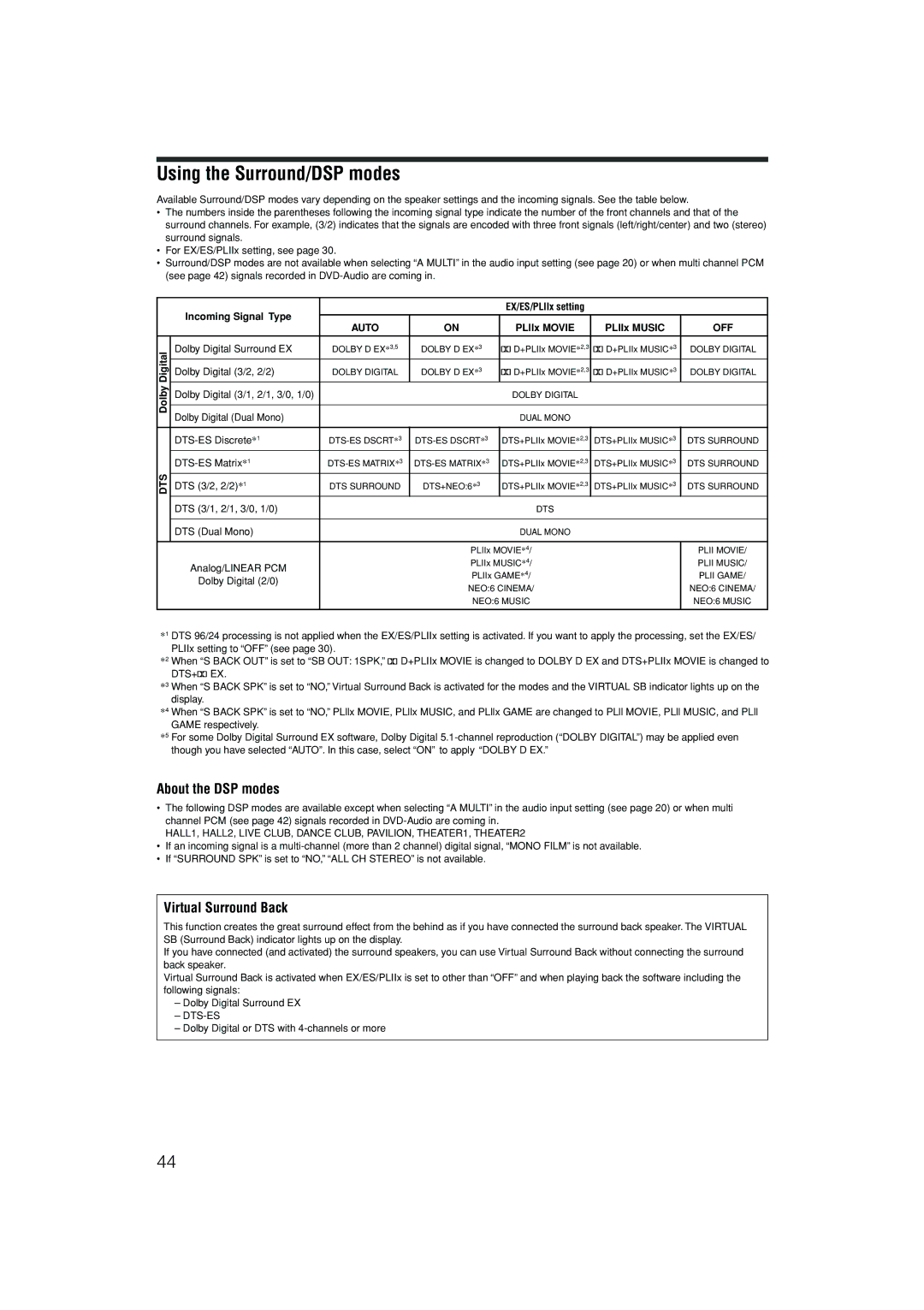
Using the Surround/DSP modes
Available Surround/DSP modes vary depending on the speaker settings and the incoming signals. See the table below.
•The numbers inside the parentheses following the incoming signal type indicate the number of the front channels and that of the surround channels. For example, (3/2) indicates that the signals are encoded with three front signals (left/right/center) and two (stereo) surround signals.
•For EX/ES/PLIIx setting, see page 30.
•Surround/DSP modes are not available when selecting “A MULTI” in the audio input setting (see page 20) or when multi channel PCM (see page 42) signals recorded in
DTSDolby Digital
Incoming Signal Type |
|
|
|
| EX/ES/PLIIx setting |
|
|
|
|
|
|
|
|
|
|
|
|
| |
AUTO |
| ON |
| PLIIx MOVIE |
| PLIIx MUSIC |
| OFF | |
|
|
|
|
| |||||
Dolby Digital Surround EX | DOLBY D EX*3,5 |
| DOLBY D EX*3 |
| D+PLIIx MOVIE*2,3 |
| D+PLIIx MUSIC*3 |
| DOLBY DIGITAL |
Dolby Digital (3/2, 2/2) | DOLBY DIGITAL |
| DOLBY D EX*3 |
| D+PLIIx MOVIE*2,3 |
| D+PLIIx MUSIC*3 |
| DOLBY DIGITAL |
Dolby Digital (3/1, 2/1, 3/0, 1/0) |
|
|
|
| DOLBY DIGITAL |
|
|
|
|
Dolby Digital (Dual Mono) |
|
|
|
| DUAL MONO |
|
|
|
|
|
| DTS+PLIIx MOVIE*2,3 |
| DTS+PLIIx MUSIC*3 |
| DTS SURROUND | |||
|
|
|
| ||||||
|
| DTS+PLIIx MOVIE*2,3 |
| DTS+PLIIx MUSIC*3 |
| DTS SURROUND | |||
DTS (3/2, 2/2)*1 | DTS SURROUND |
| DTS+NEO:6*3 |
| DTS+PLIIx MOVIE*2,3 |
| DTS+PLIIx MUSIC*3 |
| DTS SURROUND |
DTS (3/1, 2/1, 3/0, 1/0) |
|
|
|
| DTS |
|
|
|
|
DTS (Dual Mono) |
|
|
|
| DUAL MONO |
|
|
|
|
|
|
| PLIIx MOVIE*4/ |
|
|
| PLII MOVIE/ | ||
|
|
|
|
|
| ||||
Analog/LINEAR PCM |
|
| PLIIx MUSIC*4/ |
|
|
| PLII MUSIC/ | ||
|
| PLIIx GAME*4/ |
|
|
| PLII GAME/ | |||
Dolby Digital (2/0) |
|
|
|
|
| ||||
|
| NEO:6 CINEMA/ |
|
|
| NEO:6 CINEMA/ | |||
|
|
|
|
|
| ||||
|
|
| NEO:6 MUSIC |
|
|
| NEO:6 MUSIC | ||
|
|
|
|
|
|
|
|
|
|
*1 DTS 96/24 processing is not applied when the EX/ES/PLIIx setting is activated. If you want to apply the processing, set the EX/ES/ PLIIx setting to “OFF” (see page 30).
*2 When “S BACK OUT” is set to “SB OUT: 1SPK,” ![]() D+PLIIx MOVIE is changed to DOLBY D EX and DTS+PLIIx MOVIE is changed to DTS+
D+PLIIx MOVIE is changed to DOLBY D EX and DTS+PLIIx MOVIE is changed to DTS+![]() EX.
EX.
*3 When “S BACK SPK” is set to “NO,” Virtual Surround Back is activated for the modes and the VIRTUAL SB indicator lights up on the display.
*4 When “S BACK SPK” is set to “NO,” PLllx MOVIE, PLllx MUSIC, and PLllx GAME are changed to PLll MOVIE, PLll MUSIC, and PLll GAME respectively.
*5 For some Dolby Digital Surround EX software, Dolby Digital
About the DSP modes
•The following DSP modes are available except when selecting “A MULTI” in the audio input setting (see page 20) or when multi channel PCM (see page 42) signals recorded in
HALL1, HALL2, LIVE CLUB, DANCE CLUB, PAVILION, THEATER1, THEATER2
•If an incoming signal is a
•If “SURROUND SPK” is set to “NO,” “ALL CH STEREO” is not available.
Virtual Surround Back
This function creates the great surround effect from the behind as if you have connected the surround back speaker. The VIRTUAL SB (Surround Back) indicator lights up on the display.
If you have connected (and activated) the surround speakers, you can use Virtual Surround Back without connecting the surround back speaker.
Virtual Surround Back is activated when EX/ES/PLIIx is set to other than “OFF” and when playing back the software including the following signals:
–Dolby Digital Surround EX
–
–Dolby Digital or DTS with
44
